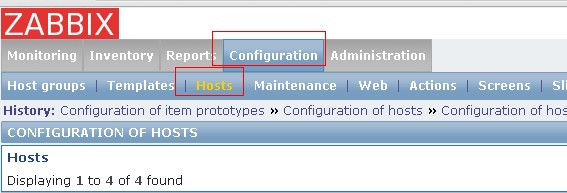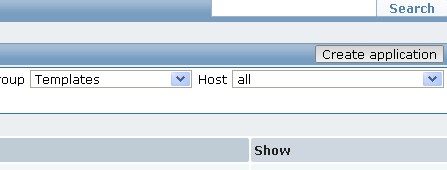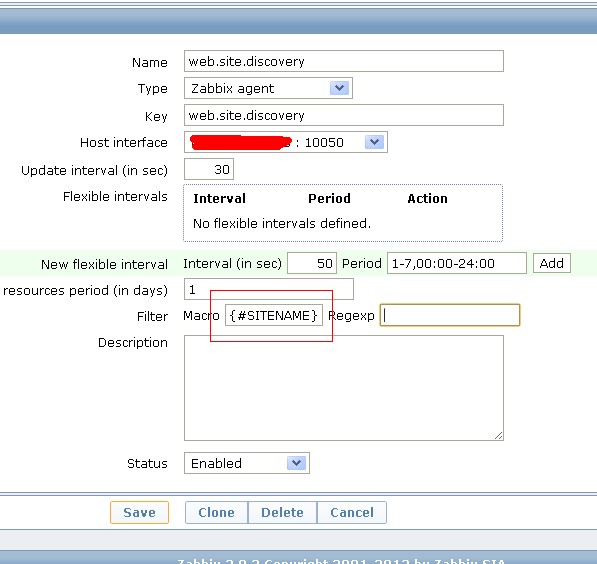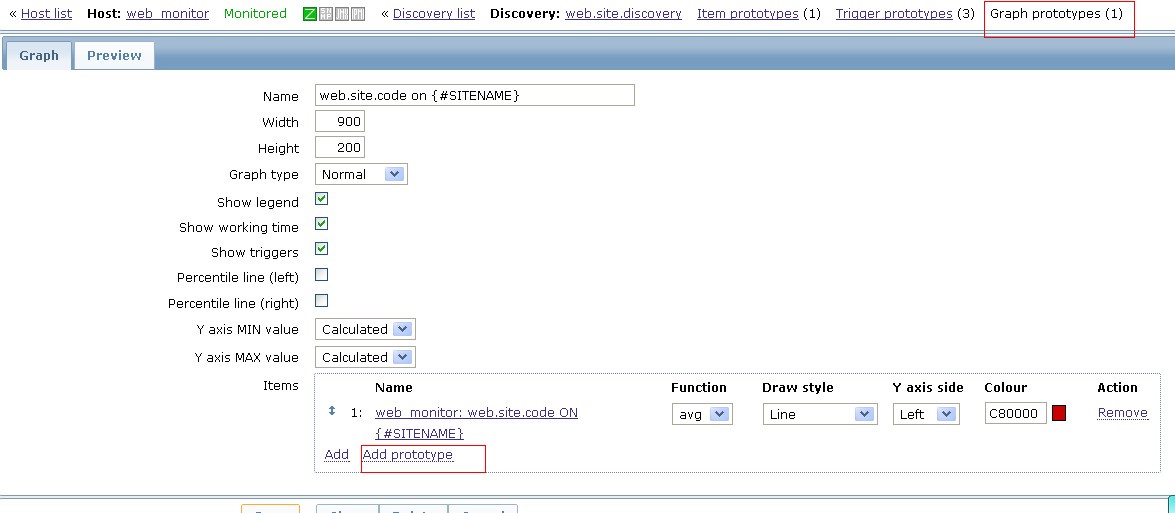Zabbix的LLD功能--Low-level discovery
感觉这个主题是和一个主题是一个系列,而且更基础。
准备深入研究一下。。。
相关文档准备:
https://www.zabbix.com/documentation/2.0/manual/discovery/low_level_discovery
http://itnihao.blog.51cto.com/1741976/1129725
Low-level discovery provides a way to automatically create items, triggers, and graphs for different entities on a computer. For instance, Zabbix can automatically start monitoring file systems or network interfaces on your machine, without the need to create items for each file system or network interface manually. Additionally it is possible to configure Zabbix to remove unneeded entities automatically based on actual results of periodically performed discovery.
In Zabbix 2.0, three types of item discovery are supported out of the box:
- discovery of file systems;
- discovery of network interfaces;
- discovery of SNMP OIDs.
A user can define their own types of discovery, provided they follow a particular JSON protocol.
The general architecture of the discovery process is as follows.
First, a user creates a discovery rule in “Configuration” → “Templates” → “Discovery” column. A discovery rule consists of (1) an item that discovers the necessary entities (for instance, file systems or network interfaces) and (2) prototypes of items, triggers, and graphs that should be created based on the value of that item.
An item that discovers the necessary entities is like a regular item seen elsewhere: the server asks a Zabbix agent (or whatever the type of the item is set to) for a value of that item, the agent responds with a textual value. The difference is that the value the agent responds with should contain a list of discovered entities in a specific JSON format. While the details of this format are only important for implementers of custom discovery checks, it is necessary to know that the returned value contains a list of macro → value pairs. For instance, item “net.if.discovery” might return two pairs: “{#IFNAME}” → “lo” and “{#IFNAME}” → “eth0”.
~~~~~~~~~~~~~~~~~~~~~~~~~~~~~~~~
需求:
现在有大量url需要监控,形式如http://itnihao.blog.51cto.com ,要求url状态不为200即报警。
需求详细分析:
大量的url,且url经常变化,现在监控用的是zabbix,如果手动添加模板,会造成大量重复工作,造成人力财力的浪费,造成休息时间的浪费,得不尝失,如果利用脚本+mail,无法图形呈现
解决方案:
zabbix有discovery功能,利用此功能,即可轻松解决此问题
zabbix客户端配置
#########cat /etc/zabbix/zabbix_agentd.conf|grep -v "^#"|grep -v "^$"##########
##此处省略N多信息,
Include=/etc/zabbix/zabbix_agentd.conf.d/ #配置文件路径
UnsafeUserParameters=1 #自定义key
###########自动发现脚本编写
########################cat /etc/zabbix/scripts/web_site_code_status##############
#!/bin/bash
# function:monitor tcp connect status from zabbix
# License: GPL
# mail:itnihao@qq.com
# version:1.0 date:2012-12-09
source /etc/bashrc >/dev/null 2>&1
source /etc/profile >/dev/null 2>&1
#/usr/bin/curl -o /dev/null -s -w %{http_code} http://$1/
WEB_SITE_discovery () {
WEB_SITE=($(cat WEB1.txt|grep -v "^#"))
printf '{\n'
printf '\t"data":[\n'
for((i=0;i<${#WEB_SITE[@]};++i))
{
num=$(echo $((${#WEB_SITE[@]}-1)))
if [ "$i" != ${num} ];
then
printf "\t\t{ \n"
printf "\t\t\t\"{#SITENAME}\":\"${WEB_SITE[$i]}\"},\n"
else
printf "\t\t{ \n"
printf "\t\t\t\"{#SITENAME}\":\"${WEB_SITE[$num]}\"}]}\n"
fi
}
}
web_site_code () {
/usr/bin/curl -o /dev/null -s -w %{http_code} http://$1
}
case "$1" in
web_site_discovery)
WEB_SITE_discovery
;;
web_site_code)
web_site_code $2
;;
*)
echo "Usage:$0 {web_site_discovery|web_site_code [URL]}"
;;
esac
客户端配置文件
#########cat /etc/zabbix/zabbix_agentd.conf.d/web_site_discovery.conf ###########
UserParameter=web.site.discovery,/etc/zabbix/scripts/web_site_code_status web_site_discovery
UserParameter=web.site.code[*],/etc/zabbix/scripts/web_site_code_status web_site_code $1
域名如下
######### cat /etc/zabbix/scripts/WEB.txt###########
www.qq.com
www.baidu.com
www.sina.com.cn
测试:
zabbix_get -s 127.0.0.1 -k web.site.discovery

zabbix_get -s 127.0.0.1 -k web.site.code[www.qq.com]
此时返回状态为200
至此,脚本,客户端配置文件OK
接下来是web的添加








报警级别的设置:3个报警级别


利用以上方法,哪怕是1000个url监控,也是分分钟的事情
总结:工欲善其事,必先利其器
参考文档:https://www.zabbix.com/documentation/2.0/manual/discovery/low_level_discovery
此外,还可以参考我写的文档:http://code.google.com/p/auto-task-pe/downloads/list zabbix自动发现监控http端口.pdf 如遇到问题,请先仔细阅读这2个文档,另外附模板文件。
欢迎交流。
http://my.itwnik.com/2013/03/zabbix-low-level-discovery-rule-script-for-md-devices/
~~~~~~~~~~~~~~~~~~~~~~~~~~~~~~~~~~~~~~~~~~~~
应用一则:
zabbix实现对web的监控有两种方式实现,一种是自带的web scenarios,基本能够实现大部分web监控的需求,但是方便简易性差很多;另一种是利用脚本+lld,可以实现任一机
器上的所有url监控,我们只需手动添加要监控的url,再加上zabbix模版的功能,就能够轻而易举的应用到所需要的监控的服务器上。
首先要感线itnihao童鞋提供的这种方式,博客地址为http://itnihao.blog.51cto.com/1741976/1129725
1.zabbix客户端配置
vim /etc/zabbix/zabbix_agent.conf
Include=/etc/zabbix/zabbix_agentd.conf
UnsafeUserParameters=1
允许用户使用自定义的参数进行传递
2.脚本及参数
[root@localhost zabbix]# tree
.
├── monitor_scripts
│ ├── discovertcpport.sh
│ ├── web_site_code_status.sh
│ └── WEB.txt
├── zabbix_agentd.conf
└── zabbix_agentd.d
├── userparameter_mysql.conf
└── web_site_discovery.conf
(1)zabbix传递参数及配置文件
[root@localhost zabbix]# cat zabbix_agentd.d/web_site_discovery.conf
UserParameter=web.site.discovery,/etc/zabbix/monitor_scripts/web_site_code_status.sh web_site_discovery
UserParameter=web.site.code[*],/etc/zabbix/monitor_scripts/web_site_code_status.sh web_site_code $1
(2)zabbix自动监控脚本
[root@localhost zabbix]# cat monitor_scripts/web_site_code_status.sh
#!/bin/bash
#function:monitor web site code status from zabbix
WEB_SITE_discovery(){
WEB_SITE=($(cat /etc/zabbix/monitor_scripts/WEB.txt |grep -v "^#"))
printf '{\n'
printf '\t"data":[\n'
for((i=0;i<${#WEB_SITE[@]};i++))
{
num=$(echo $((${#WEB_SITE[@]}-1)))
if [ "$i" != ${num} ];then
printf "\t\t{ \n"
printf "\t\t\t\"{#SITENAME}\":\"${WEB_SITE[$i]}\"},\n"
else
printf "\t\t{ \n"
printf "\t\t\t\"{#SITENAME}\":\"${WEB_SITE[$num]}\"}]}\n"
fi
}
}
web_site_code(){
/usr/bin/curl -o /dev/null -s -w %{http_code} http://$1
}
case "$1" in
web_site_discovery)
WEB_SITE_discovery
;;
web_site_code)
web_site_code $2
;;
*)
echo "Usage:$0 {web_site_discovery|web_site_code[URL]}"
;;
esac
(3)需要监控的url在WEB.TXT中
[root@localhost zabbix]# cat monitor_scripts/WEB.txt
s1.xd.com/Default.aspx
s2.xd.com/Default.aspx
3.在zabbix服务端进行监控测试
[root@83 yum.repos.d]# /usr/bin/zabbix_get -s 192.168.1.211 -p 10050 -k web.site.code[s1.xd.com/Default.aspx]
200
[root@83 yum.repos.d]# /usr/bin/zabbix_get -s 192.168.1.211 -p 10050 -k web.site.discovery
{
"data":[
{
"{#SITENAME}":"s1.xd.com/Default.aspx"},
{
"{#SITENAME}":"s2.xd.com/Default.aspx"}]}
测试成功
4.下面我们来配置下discovery模版,配好后直接应用到服务器即可。
(1)创建模版,并应用到需要监控的服务器上
(2)在新建的Template Web Monitor模版的Application中创建新应用
(3)在在新建的Template Web Monitor模版的Discovery rules中创建新rule
(4)在新建的web.site.discovery中创建Item porototyoed
(5)在新建的web.site.discovery中创建Trigger porotypes,此处设置为状态码大于399就报警。
ok,配置完后我们的web url监控就完成了
~~~~~~~~~~~~~~~~~~~~~~~~~~~~~~~
Zabbix的LLD功能--Low-level discovery的更多相关文章
- Zabbix监控Low level discovery实时监控网站URL状态
今天我们来聊一聊Low level discovery这个功能,我们为什么要用到loe level discovery这个功能呢? 很多时候,在使用zabbix监控一些东西,需要对类似于Itens进行 ...
- zabbix监控redis多实例(low level discovery)
对于多实例部署的tomcat.redis等应用,可以利用zabbix的low level discovery功能来实现监控,减少重复操作. 注:Zabbix版本: Zabbix 3.0.2 一.服务 ...
- zabbix(10)自动发现规则(low level discovery)
1.概念 在配置Iterms的过程中,有时候需要对类似的Iterms进行添加,这些Iterms具有共同的特征,表现为某些特定的参数是变量,而其他设置都是一样的,例如:一个程序有多个端口,而需要对端口配 ...
- zabbix 用 LLD 完全自动化监控 Oracle
文章转载自:http://mp.weixin.qq.com/s?__biz=MzA3MzYwNjQ3NA==&mid=2651296856&idx=1&sn=2bdf78071 ...
- Solr实现Low Level查询解析(QParser)
Solr实现Low Level查询解析(QParser) Solr基于Lucene提供了方便的查询解析和搜索服务器的功能,可以以插件的方式集成,非常容易的扩展我们自己需要的查询解析方式.其中,Solr ...
- zabbix自动发现功能实现批量web url监控
需求: 现在有大量url需要监控,形式如http://www.baidu.com ,要求url状态不为200即报警. 需求详细分析: 大量的url,且url经常变化,现在监控用的是zabbix,如果手 ...
- 使用Java Low Level REST Client操作elasticsearch
Java REST客户端有两种风格: Java低级别REST客户端(Java Low Level REST Client,以后都简称低级客户端算了,难得码字):Elasticsearch的官方low- ...
- C++ Low level performance optimize 2
C++ Low level performance optimize 2 上一篇 文章讨论了一些底层代码的优化技巧,本文继续讨论一些相关的内容. 首先,上一篇文章讨论cache missing的重要性 ...
- C++ Low level performance optimize
C++ Low level performance optimize 1. May I have 1 bit ? 下面两段代码,哪一个占用空间更少,那个速度更快?思考10秒再继续往下看:) //v1 ...
随机推荐
- 【Linux学习笔记】用nc实现两台主机间的文件传输(不需要输密码)
通常,可以用scp完成两台主机间的文件传输任务,但在主机间未建立信任关系的情况下,scp每次都需要输入密码,用起来感觉不是很方便,之前这篇笔记介绍过不用输入密码执行脚本或传输文件的方法,但对于一些临时 ...
- iOS--NSAttributedString使用介绍
iOS–NSAttributedString使用介绍 原文见: http://www.itnose.net/detail/6177538.html http://***/html/topnews201 ...
- Scope Chain(作用域链)
本章,我们讨论一下ECMAScript中的作用域链 , 开门见山. 什么是作用域链 i.ECMAScript是允许创建内部函数的,甚至能从父函数中返回这些函数.作用域链正是内部上下文中所有变量对象(及 ...
- [转] What is the point of redux when using react?
As I am sure you have heard a bunch of times, by now, React is the V in MVC. I think you can think o ...
- [iOS开发] 使用第三方字体不生效
iOS中使用第三方字体并不复杂,通常只需要如下三个步骤: 1. 将第三方字体文件添加到工程(Project)中: 2. 在info.plist中添加一个新的键"Fonts provided ...
- linux的openfire运行日志配置经历
openfire的日志可以通过/usr/openfire/lib/log4j.xml(与openfire的安装目录有关,我的openfire是安装在/usr/openfire/)的xml配置文件进行设 ...
- CTE在Oracle和Sqlserver中使用的差异
CTE是一个很好用的工具,他可以帮助我们清晰代码结构,减少临时表使用,同时oracle和sqlserver都提供支持.但在oracle和sqlserver中使用CTE也存在一定区别. Oracle使用 ...
- Codeforces 231E - Cactus
231E - Cactus 给一个10^5个点的无向图,每个点最多属于一个环,规定两点之间的简单路:从起点到终点,经过的边不重复 给10^5个询问,每个询问两个点,问这两个点之间有多少条简单路. 挺综 ...
- 10.24 noip模拟试题
尼玛pdf依旧不会粘23333 /* 每段合并到总的里面 假设总的有X个 这一段有Y个 一共有X+1个空 那么就有 C(X+1,1)+C(X+1,2)+C(X+1,3)+...+C(X+1,Y) 这样 ...
- .NET中TextBox控件设置ReadOnly=true后台取不到值三种解决方法
当TextBox设置了ReadOnly=true后要是在前台为控件添加了值,后台是取不到的,值为空,多么郁闷的一个问题经过尝试,发现可以通过如下的方式解决这个问题.感兴趣的朋友可以了解下 当TextB ...








